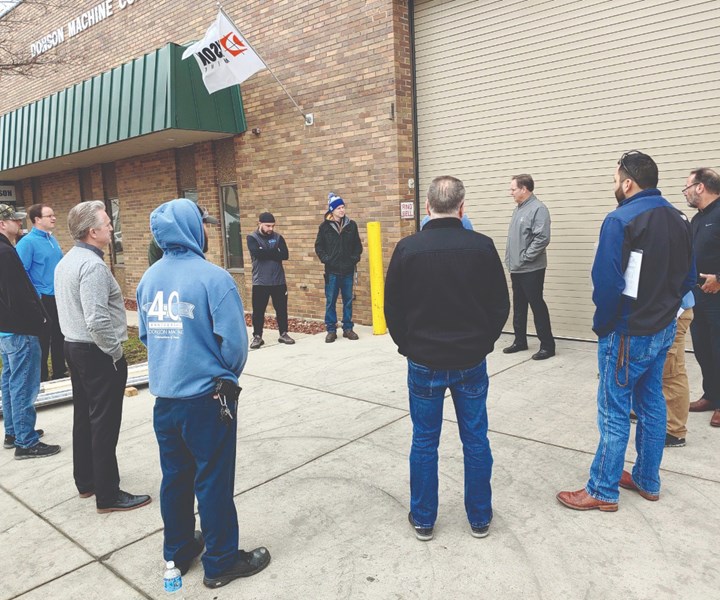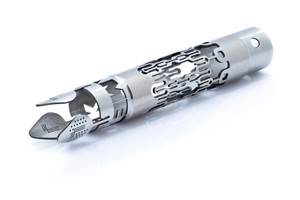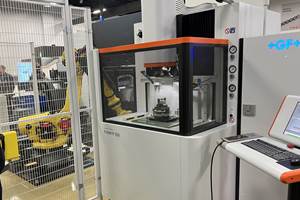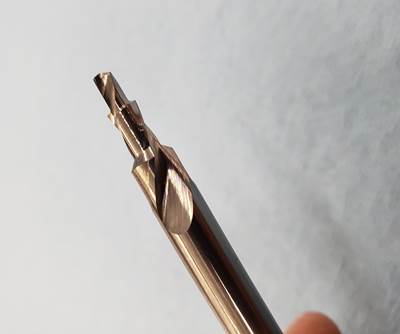Team Thinking Helps Donson Machine with Nickel Alloy Ventilator Part Production
This shop has taken unusual steps to draw on its strengths as a well-equipped machining facility with a skilled workforce to match.
Share

The picture here might look ordinary: a bunch of guys standing around. Not so. The setting is the concrete apron to the high-bay loading area near the front entrance of Donson Machine, a contract manufacturer in Alsip, Illinois. The picture shows the company’s management team considering their options to meet the urgent needs of its customers for ventilator components to respond to COVID-19. Normally, the group would huddle indoors, but meeting in fresh air to obtain as much distance as the group practically could was the appropriate alternative.
Leading the meeting seen here are brothers Joe and Jim Bettinardi, president and CEO respectively, but only Joe is visible with his back to the rollup door. Donson Machine was a recent MMS Top Shops winner in the category of machining technology. Joe Bettinardi says the times right now reinforce an important point about technology and this shop’s application of it:
“You can have the most flexible, capable and productive CNC machines on your shop floor, but you need a shop floor workforce with the flexibility, capability and productivity to match,” he explains. Donson Machine was tasked with producing some of the most complex and critical ventilator components in a high-nickel alloy, a workpiece material familiar to the shop because it is frequently encountered in the medical equipment, orthopedics and food processing part production that are its specialty in normal times.
However, the ventilator components are just different enough from past work that the shop wanted to be sure it brought the best collective thinking to bear for ramping up production and deploying its most valuable asset, its cadre of skilled CNC programmers and machinists.
“We couldn’t afford missteps or miss out on a workflow built on optimized machining strategies that maximized our capability for manufacturing complex parts in one path on a single machine,” Mr. Bettinardi says. He also adds that his company is committed to keeping all of its employees as safe as possible and the group discussed the best course of action in keeping with national guidelines.
Although details about the ventilator parts are confidential, Mr. Bettinardi could share this much: “The parts we make for ventilators are mostly done on multi-axis equipment so everything comes out complete. Hundreds of parts go into a ventilator and we need to make sure we send perfect parts to our customer so that we never slow down another ventilator getting shipped to a hospital.”
Joe and Jim Bettinardi offered a few other key points about this experience with producing the ventilator parts under unusual conditions:
- It will test your shop culture. Trust and cooperation, especially when people are always several arm lengths apart or even interacting remotely, are vital.
- It brings out the value and the limitations of automation. You have to understand how accommodating changing job priorities has to be balanced against minimizing cycle times.
- There can be no shortcuts or corner-cutting in the rush. Here is where habitual efficiency, especially in quality assurance procedures, pays off. Focus and discipline are essential.
- Secondary operations can be of prime importance. You have to maintain the best practices in part deburring, cleaning, packaging, labeling and so on to deliver truly complete parts.
Mr. Bettinardi offered one more comment, which reflects his own company but probably many other American job shops. “I always knew we had great employees, but what I have seen the last few weeks makes me so proud of the spirit of our team members. These are people of extremely high character. At least once a day, someone comes into my office and asks, ‘What else can I do to help?’”
Related Content
-
Ametek EMC Laser Cutting System Offers Through-Part Cooling
The new laser cutting system offers comprehensive Swiss machining capabilities, as well as through-part cooling and automatic part-handling options.
-
Kennametal Turning Tools Enhance Small Part, Medical Machining
TopSwiss Micro Boring Solid tooling and KCU25B turning inserts are well suited for the small parts and medical machining space.
-
EDM, Laser Micromachining and More at GF Medical Demo Center
At GF’s Medical Center of Competence, the company shows off EDM and laser features that could make a large impact on medical manufacturing — and elsewhere.
Related Content
Ametek EMC Laser Cutting System Offers Through-Part Cooling
The new laser cutting system offers comprehensive Swiss machining capabilities, as well as through-part cooling and automatic part-handling options.
Read MoreKennametal Turning Tools Enhance Small Part, Medical Machining
TopSwiss Micro Boring Solid tooling and KCU25B turning inserts are well suited for the small parts and medical machining space.
Read MoreEDM, Laser Micromachining and More at GF Medical Demo Center
At GF’s Medical Center of Competence, the company shows off EDM and laser features that could make a large impact on medical manufacturing — and elsewhere.
Read MoreGerman Project Yields Three New Medical Machining Processes
Trends to Watch at IMTS: Recent research has resulted in a new mix of high-speed turn whirl milling, polygon turning and rotational turning for manufacturing medical bone screws and out-of-round nails.
Read MoreRead Next
Shop Starts Work on Custom Drill for Ventilators Before Purchase Order Came
When this Indiana toolmaker saw an order for cutting tools to make ventilators for coronavirus patients, his workers started grinding before the customer officially hired them.
Read MoreAerospace Supplier Shifts to Tight-Tolerance Ventilator Parts: "We Weren't in This Business Two Weeks Ago"
Skilled Manufacturing Inc. is running seven days a week to produce ventilator parts that will help healthcare workers battle the coronavirus.
Read MoreDie Maker Describes Five-Day Build for Tool Urgently Needed for Coronavirus Ventilator Production
Running 11 five-axis machines simultaneously, a die maker reduced a five week lead time to just five days. Here’s how.
Read More









